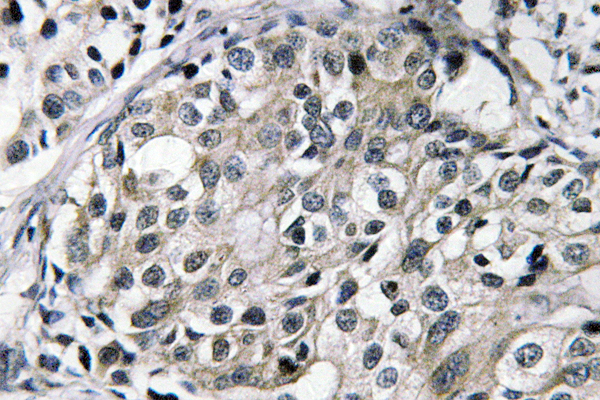TAT Polyclonal Antibody
- Catalog No.:YT4543
- Applications:IHC;IF;ELISA
- Reactivity:Human;Mouse;Rat
- Target:
- TAT
- Fields:
- >>Ubiquinone and other terpenoid-quinone biosynthesis;>>Cysteine and methionine metabolism;>>Tyrosine metabolism;>>Phenylalanine metabolism;>>Phenylalanine, tyrosine and tryptophan biosynthesis;>>Metabolic pathways
- Gene Name:
- TAT
- Protein Name:
- Tyrosine aminotransferase
- Human Gene Id:
- 6898
- Human Swiss Prot No:
- P17735
- Mouse Gene Id:
- 234724
- Mouse Swiss Prot No:
- Q8QZR1
- Rat Gene Id:
- 24813
- Rat Swiss Prot No:
- P04694
- Immunogen:
- The antiserum was produced against synthesized peptide derived from human TAT. AA range:255-304
- Specificity:
- TAT Polyclonal Antibody detects endogenous levels of TAT protein.
- Formulation:
- Liquid in PBS containing 50% glycerol, 0.5% BSA and 0.02% sodium azide.
- Source:
- Polyclonal, Rabbit,IgG
- Dilution:
- IHC 1:100 - 1:300. ELISA: 1:40000.. IF 1:50-200
- Purification:
- The antibody was affinity-purified from rabbit antiserum by affinity-chromatography using epitope-specific immunogen.
- Concentration:
- 1 mg/ml
- Storage Stability:
- -15°C to -25°C/1 year(Do not lower than -25°C)
- Other Name:
- TAT;Tyrosine aminotransferase;TAT;L-tyrosine:2-oxoglutarate aminotransferase
- Molecular Weight(Da):
- 50kD
- Background:
- This nuclear gene encodes a mitochondrial protein tyrosine aminotransferase which is present in the liver and catalyzes the conversion of L-tyrosine into p-hydroxyphenylpyruvate. Mutations in this gene cause tyrosinemia (type II, Richner-Hanhart syndrome), a disorder accompanied by major skin and corneal lesions, with possible mental retardation. A regulator gene for tyrosine aminotransferase is X-linked. [provided by RefSeq, Jul 2008],
- Function:
- catalytic activity:L-tyrosine + 2-oxoglutarate = 4-hydroxyphenylpyruvate + L-glutamate.,cofactor:Pyridoxal phosphate.,disease:Defects in TAT are the cause of tyrosinemia type 2 (TYRO2) [MIM:276600]; also known as Richner-Hanhart syndrome. TYRO2 is an inborn error of metabolism characterized by elevations of tyrosine in the blood and urine, and oculocutaneous manifestations. Typical features include palmoplantar keratosis, painful corneal ulcers, and mental retardation.,pathway:Amino-acid degradation; L-phenylalanine degradation; acetoacetic acid and fumarate from L-phenylalanine: step 2/6.,similarity:Belongs to the class-I pyridoxal-phosphate-dependent aminotransferase family.,subunit:Homodimer.,
- Subcellular Location:
- mitochondrion,cytosol,
- Expression:
- Liver,
- June 19-2018
- WESTERN IMMUNOBLOTTING PROTOCOL
- June 19-2018
- IMMUNOHISTOCHEMISTRY-PARAFFIN PROTOCOL
- June 19-2018
- IMMUNOFLUORESCENCE PROTOCOL
- September 08-2020
- FLOW-CYTOMEYRT-PROTOCOL
- May 20-2022
- Cell-Based ELISA│解您多样本WB检测之困扰
- July 13-2018
- CELL-BASED-ELISA-PROTOCOL-FOR-ACETYL-PROTEIN
- July 13-2018
- CELL-BASED-ELISA-PROTOCOL-FOR-PHOSPHO-PROTEIN
- July 13-2018
- Antibody-FAQs
- Products Images

- Immunohistochemistry analysis of TAT antibody in paraffin-embedded human breast carcinoma tissue.



